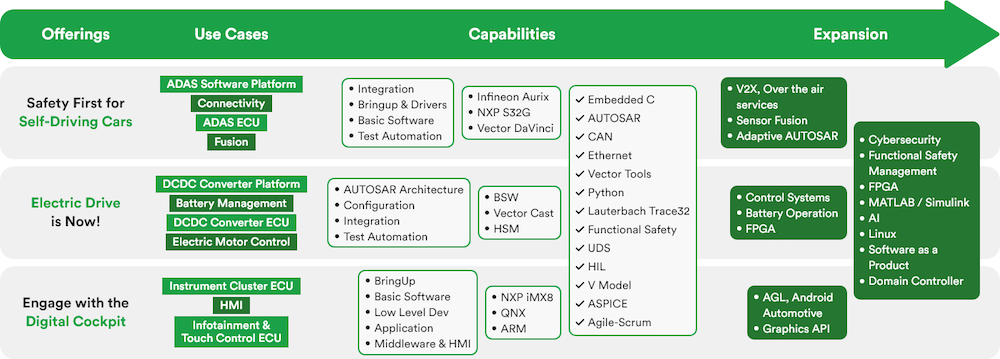
AI-Powered LiDAR: A New Era of Perception
How AI and ML enhance LiDAR technology by overcoming data processing challenges, enabling advanced applications in autonomous systems, robotics, and 3D mapping, and more.
Linux is revolutionizing the automotive industry through Automotive Grade Linux (AGL) – a consortium of automotive and technology companies and suppliers, just as it revolutionized software development decades ago.
AGL aims to become the de facto industry standard to enable rapid development of new features and technologies in automotive technology products.
This article explores explores how AGL facilitates and streamlines infotainment and instrument cluster solutions development and why OEMs should consider tapping into this platform for their projects.
Open-source software will drive much of the innovation. Linux is revolutionizing the automotive industry through Automotive Grade Linux (AGL) – a consortium of automotive and technology companies and suppliers, just as it revolutionized software development decades ago.
AGL aims to become the de facto industry standard to enable rapid development of new features in automotive technology products.
OEMs are increasingly interested in reducing software development and deployment times and adding new features with OTA updates. AGL brings together carmakers, suppliers, and technology companies with the common goal of creating a standardized Linux-based open software platform for automotive application development.
Why open source? It creates a unique ecosystem that enables vendors to use common standards and reusable code to reduce software time to market, enhance security, and provide robust customisation features.
Since AGL released the industry’s first Open Vehicle Infotainment (IVI) software specification in 2015, the team has expanded its scope to focus on digital cockpit solutions such as dashboard, HUDs, telematics, ADAS, and autonomous driving.
By creating standard code, car manufacturers and their partners can create useful applications and platforms that deliver more value and provide unique experiences to consumers. Today, the AGL-based car infotainment system proves to be one of the best solutions for OEMs.
According to the Linux Foundation, their collaborative open-source AGL project currently has over 150 contributors. Of them, 11 are car makers, including Toyota and Subaru. They’ve already deployed the AGL platform in many of their models. While AGL has made significant strides in its latest releases, the Blackberry QNX platform is by far the dominant leader, with deployment figures exceeding 150 million vehicles worldwide.
While Blackberry is the clear market leader, there is no shortage of quality competition from companies such as WindRiver, Green Hills, Nvidia, Mentor, Google, Apple, and AGL.
It remains to be seen whether AGL will become the leading platform in the market in the coming years, but it is safe to say that by 2025 the market will likely look very different from today’s. As the global automotive IoT market is expected to exceed €100 billion by the mid-2020s, the winner will take it all. Like legit.
AGL covers 70 to 80% of all off-the-shelf features required for the quality in-car infortainment solution development. It offers automakers and vehicle suppliers the ability to quickly and easily customize the technology, reducing time to market and increasing brand loyalty.
Other benefits include:
Having an open-source and shared resource to deploy patches and keep platform security up to date is a considerable advantage over requiring OEMs to manage their baseline security, especially when many attackers look to break and infect software systems.
Due to changing consumer demands, automotive OEMs do not have the capacity and/or resources to continuously create new software from scratch. By providing universal standards, OEMs can focus on last-mile customization that will help them stand out.
AGL gives OEMs the efficiency of open-source code while providing control over UX design, including branding and ease of adding additional services.
AGL’s expansion into other areas such as telemetry and ADAS means the OEM can manage fewer platforms, which is critical for autonomous and electric vehicles.
As a proof of our automotive software development expertise, we at rinf.tech have built and deployed our own PoC version of AGL Instrument Cluster on a Raspberry Pi 3. We’re currently adding new features and working on its UX design.
For rapid prototyping and code reusability between different ECU platforms, we used Yocto Platform that allows automotive developers to build custom Linux-based systems regardless of the hardware architecture.
We’ve also attached a CAN board for Automotive CAN communication with another Raspberry PI 3 board. The second board sends CAN signals to the AGL board which reads and interprets the messages as on-screen signals.
Our AGL PoC features:
As a development methodology, we used Cycle-V process following ASPICE polices.


How AI and ML enhance LiDAR technology by overcoming data processing challenges, enabling advanced applications in autonomous systems, robotics, and 3D mapping, and more.

Offering insights into how the latest AI advancements will impact consumers, manufacturers, and the broader environment in 2025 and beyond.

Showcasing the environmental and economic benefits of integrating sustainable materials and robust recycling practices into the automotive value chain.